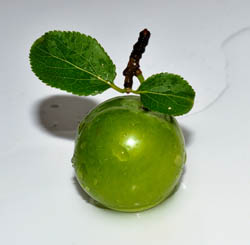Greengage jam recipe
Posted by Fiona Nevile in Jam Jelly and Preserves | 26 comments
Photograph courtesy of ilco
“Do you think that my greengage jam has set enough?”
The chicken lady passed me a teaspoon filled with greengage loveliness. It was excellent, not too runny. And the taste was superb.
“I used less sugar than the recipe as we don’t like jam to be too sweet.”
“I heard once that if you include some kernels it helps it to set.”
“Funny that you should say that. My grandmother always included almonds in her greengage jam.”
“Perhaps they were kernels?”
TCL had given me a haul of greengages and I couldn’t wait to get home and make jam. Greengages are my favourite fruit and they are so difficult to get hold of around here.
Pam Corbin in her book Preserves: River Cottage Handbook No.2 notes that the pectin in greengages is medium, whereas the pectin in damsons and unripe plums is high. Like TCL I like my jam to be quite tart. This means that it can be used for cooking as well as spreading on toast. So I added the juice of a small lemon (which is high in pectin) to the fruit and got a good ‘set’. If you like your jam to be very sweet just add more sugar incrementally, tasting after it had dissolved, before bringing the fruit to the boil.
Choose firm greengages and eat the soft ones as they do not make nearly such good jam.
Greengage jam recipe
Ingredients:
900g/2 lbs of greengages
675g/1.5 lbs of white granulated sugar
Half a pint/275ml of water
The juice of a small lemon
Method:
1. Wash the fruit and discard any damaged ones.
2. Put the fruit, lemon juice and water into a large heavy bottomed saucepan (or preserving pan) and simmer gently until the skins split and they are soft.
3. Meanwhile, warm the sugar in a low oven for ten minutes and add to the fruit.
4. Stir gently over a low heat until you are sure that all the sugar crystals have dissolved.
5. Turn up the heat to a medium high setting and, stirring frequently, let the fruit boil rapidly for 10 minutes (this is called a rolling boil).
6. Remove the stones with a slotted spoon during the boiling process.
7. Test for set (What is set/setting point? See tricks and tips below).
8. If the jam has not set, continue to boil rapidly and test at five minute intervals.
9. When the jam has set carefully pour into warm, sterilised jars, using a ladle or small jug. (How to sterilise jars? See tricks and tips below)
10. Cover the jars with tight fitting screw-top lids, or waxed disks and cellophane pot covers (waxed disks, wax facing downwards and plastic covers secured with plastic bands).
11. Label when cold and store in a cool, dark place, away from damp.
Tips and tricks:
Jam “set” or “setting point”:
Getting the right set can be tricky. I have tried using a jam thermometer but find it easier to use the following method. Before you start to make the jam, put a couple of plates in the fridge so that the warm jam can be drizzled onto a cold plate (when we make jam we often forget to return the plate to the fridge between tests, using two plates means that you have a spare cold plate). Take your jam pan off the heat and return the plate to the fridge to cool for approx two minutes. It has set when you run your finger through it and leave a crinkly track mark. If after two minutes the cooled jam is too liquid, continue to boil the jam, testing it every few minutes until you have the right set. The jam is far more delicious if it is slightly runny.
Sterilising the jars:
We collect jars all year round for our jelly, chutney and jam making sessions. I try to soak off labels and store the clean jars and metal plastic coated screw-top lids in an accessible place. The sterilising method that we used is simple. Just before making the jam, I quickly wash and rinse the jars and place them upside down in a cold oven. Set the temperature to 160c/140c for fan assisted. When the oven has reached the right temperature I turn off the heat. The jars will stay warm for quite a while. I only use plastic lined lids for preserves as the all-metal lids can go rusty. I boil these for five minutes in water to sterilise them. If I use Le Parfait jars, I do the same with the rubber rings.
NB Damson Jam: This recipe works well with damsons.
Leave a reply






My greengage jam has got cristation in the jars as it’s the first time I’ve made greengage jam does this mean I have ruined it
Greengage jams are awesome, this is my second year, and I simply can’t resist it.
Please tell us how many 350g jars this fills